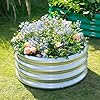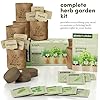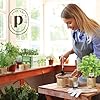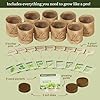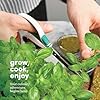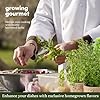Onelike 48'' x 16'' x 55.5'' Plastic Raised Garden Bed with Greenhouse Cover and Trellis, Vertical Tomato Planters for Climbing Plants, Self Watering System Tomatoes Cage for Patio,Black,Large
$99.99 (as of 14:42 GMT -05:00 - More infoProduct prices and availability are accurate as of the date/time indicated and are subject to change. Any price and availability information displayed on [relevant Amazon Site(s), as applicable] at the time of purchase will apply to the purchase of this product.)Land Guard Galvanized Raised Garden Bed 2Pcs, Planter Raised Garden Beds Outdoor, Round Clearance Raised Garden Beds for Gardening Vegetables……
$49.99 (as of 14:39 GMT -05:00 - More infoProduct prices and availability are accurate as of the date/time indicated and are subject to change. Any price and availability information displayed on [relevant Amazon Site(s), as applicable] at the time of purchase will apply to the purchase of this product.)Composting is a simple and effective way to reduce waste, save money on fertilizer, and create nutrient-rich soil for your garden. If you’re new to composting or have been thinking about starting, this beginner’s guide will help get you started in no time!
What Is Composting and Why Should You Start?
Composting is the process of breaking down organic matter such as food scraps, yard trimmings, and animal manure into a rich, nutritious soil amendment called compost. It’s an eco-friendly alternative to throwing these materials away in the garbage, which not only takes up space in landfills but also produces methane gas, a potent greenhouse gas. By composting at home, you can divert hundreds of pounds of organic material from the landfill each year while creating a valuable resource for your garden.
The Basics of Starting Your Own Compost Pile
To start composting at home, you’ll need three things: brown material (such as leaves or shredded paper), green material (such as fruit and vegetable scraps or grass clippings), and water. Mix these ingredients together in a pile or bin, and let nature take its course. Here are some tips for getting started:
1. Choose the right location – Look for a spot that gets plenty of sunlight and has good drainage. Avoid placing your compost pile near trees or buildings, as the heat generated by the decomposing material could cause damage.
2. Size matters – The ideal size for a compost pile depends on how much organic material you generate. As a general rule, aim for a pile that’s between 3-4 feet wide, long, and high. This allows for enough airflow and moisture to support the decomposition process.
3. Balance is key – To ensure your compost pile cooks properly, try to maintain a balance between brown and green materials. Aim for a ratio of two parts brown to one part green.
4. Turn it over – One of the most important steps in making great compost is turning the pile regularly. This helps aerate the material and distribute moisture evenly throughout the pile. Use a pitchfork or other tool to turn the pile every few days until it reaches the desired temperature (usually around 150°F).
Tips for Maintaining a Healthy Compost Pile
Once you’ve gotten your compost pile going, there are several ways to keep it healthy and productive. Some tips include:
1. Keep it moist – Compost needs just the right amount of moisture to break down efficiently. Add water if the pile feels too dry, but avoid overwatering, which can lead to odors and slow decomposition.
2. Stir it up – Continue to turn the pile regularly to promote aeration and mix in any new additions.
3. Monitor the temperature – Ideally, your compost should reach temperatures above 130°F to kill off pathogens and weed seeds. Check the temperature with a thermometer to make sure it stays within the optimal range.

4. Control pests – Rodents and insects may be attracted to your compost pile. To prevent them from becoming a problem, cover the pile with a tarp or use natural repellants like citrus peel or cayenne pepper.
Troubleshooting Common Composting Problems
Even experienced composters sometimes run into problems when trying to make quality compost. Here are some common issues and solutions:
1. Odor – If your compost smells sour or unpleasant, it likely means there’s too much wet material or not enough oxygen flowing through the pile. Try adding more browns or turning the pile more frequently.
2. Slow decomposition – If your compost isn’t heating up or breaking down quickly enough, check the moisture level and adjust accordingly. Also, consider adding more nitrogen-rich greens or turning the pile more often.
3. Disease – If you notice diseased plants in your garden, it could be due to using contaminated compost. Make sure to sterilize any tools or containers used during the composting process to prevent cross-contamination.
How to Use Your Homemade Compost in the Garden
Once your compost has fully broken down and cooled, it’s ready to use in your garden! Here are some ideas for putting your homemade compost to work:
1. Amend soil – Mix your compost into existing soil before planting to improve drainage and increase nutrient availability.
2. Top dressing – Spread a thin layer of compost on top of your soil surface to provide a boost of nutrients and encourage beneficial microorganisms.
3. Potting mix – Use your compost instead of store-bought potting soil to give houseplants and seedlings a head start.
In conclusion, composting is a fun and rewarding hobby that anyone can do at home. With these tips and techniques, you’ll be well on your way to reducing waste, saving money, and growing healthier plants in no time!
Related Content
- Durham Fair recycling and composting projects underway in ’22 – The Middletown Press
- Sanwo-Olu Unveils Lagos Action Plan to Battle Climate Change Challenges
- Kean Researchers Seek Environmental Solutions in the Trash | Westfield, NJ News TAPinto
- Waterless Urinal Market Future Analysis in a New Study Report[PDF] 2021-2027 | Top …
- Why Interplanting Herbs Is BETTER Than Growing An Herb Garden









